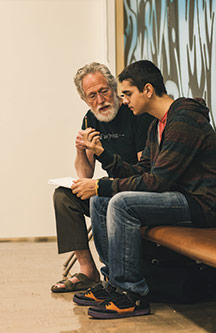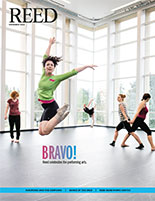
IRIS login | Reed College home Volume 92, No. 4: December 2013
Adolescent Drama
Bruce Livingston ’65 helps troubled teens harness the power of narrative.
By Randall S. Barton

DIGGING DEEP. Bruce Livingston ’65 talks about pain, art, and Death of a Salesman with a tenth-grader from an alternative school. Photo by Matt D'Annunzio
Sixty years old and tired of selling on the road, Willy Loman asks his boss for a desk job. Instead, he gets the boot.
“I’ve put 34 years into this firm,” Willy remonstrates. “You can’t eat the orange and throw the peel away—a man is not a piece of fruit.”
The brutal scene from Death of a Salesman has electrified audiences since it opened in 1949. It’s often hailed as a work of art. But for Bruce Livingston ’65, it is also a form of therapy.
He shows the scene to students in his PlayWrite program and asks them to deconstruct the scene. What’s going on? What does Willy really want?
“He doesn’t want to be on the road,” one offers. “He’s really tired,” suggests another. “Sooner or later,” says Bruce, “some kid will say, ‘He wants respect.’ You get goose bumps when you hear that.”
Ten years ago, Bruce founded PlayWrite to give “youth at the edge” a chance to find their voices in the process of creating plays. The program is aimed at teens who suffer from neglect, inadequate parenting, or physical, emotional, or sexual abuse. Approximately 10% have experienced pregnancy and parenthood.
Bruce puts this in context: “As author Barry Lopez says, ‘We are all wounded animals.’ Every one of us falls on a continuum of trauma experience. I don’t want the kids to feel that people think of them as ‘abused kids.’ They want to be seen for themselves, just as they are.”
The program has proven results. A study by researchers from the University of Oregon and Oregon Health & Science University found that troubled teens who took part in the workshop showed less anxiety, depression, restlessness, and distraction than those who didn’t. They demonstrated greater abilities to experience happiness and regulate anger.
The program pairs students with coaches for seminars that typically run over two weeks. They learn to work collaboratively, build trust, and bring closure to emotional experiences. The idea is that students have the answers and it’s the coach’s job to bring them forth.
“The work we do may have therapeutic consequences,” Bruce allows, “but we are not therapists.”
He believes PlayWrite’s program can effectively rewire the brain. “The brain is plastic; it can change,” he says. “If you activate kids on something, then calm things down, bring it up and then calm things down, you allow the time and neurological space to put things together unconsciously.”
![]()
Never one for planning his life, Bruce kept his antennae attuned for enlightening exploits and “things popped up.”
Growing up in Portland, he thrilled to stories about the deeds of his great grandfather, C.E.S. Wood, who served alongside General O.O. Howard and is credited with jotting down Chief Joseph’s famous “I will fight no more” speech. Later he was fascinated with places like India, Egypt, and Cameroon. By the time he started at Reed, anthropology seemed the obvious major. “I’ve always sought adventure, loving the edges—physically at first,” says Bruce, “and Reed turned on the intellectual afterburner. What stuck was the challenge and excitement of finding a problem and opening every door that might lead to a connection.”
For the next three decades, he resolutely opened doors. He did anthropological fieldwork with the Chilcotin tribe in British Columbia. Made a living as a hippie carpenter on the Metolius River in Oregon. Got an MA in anthropology from the University of Chicago. Oversaw a construction project in Iran. As the Islamic Revolution began to unfold, he moved to Paris and apprenticed with chef Claude LeGras at Chez Provost, and then he returned to Oregon and opened La Cigale, an award-winning restaurant in Redmond.
In 1996 he met actress Gretchen Corbett, founder of the Haven Project, which connected underserved youth with theatre professionals. She asked him to collaborate with a nine-year-old girl in writing a two-character drama.
“Sitting with this skinny, little African American girl, sharing each other’s stories, was an extraordinary experience,” Bruce recalls. He was amazed at the dramatic improvement among the kids who took part in the program. After serving as managing director of the Haven Project for three years, Bruce started PlayWrite in 2003.
![]()
PlayWrite draws participants from special-needs schools around Portland, including Alliance High School at Benson, Mt. Scott Learning Center, Rosemont School, the Rosemary Anderson High School (East Campus), Youth Progress, the White Shield Center, and Bienestar.
Many of the students have not seen live theatre and don’t realize that drama-
tic action requires conflict.
“If there’s no conflict, it’s boring—and the worst crime in playwriting is boring your audience. We know your parents and teachers are always advocating that you avoid conflict. But for the next two weeks, we say, ‘Go for it.’ Dig into that conflict and find out what the roots are. Bring it to life.”
Participants watch famous theatrical scenes, including Hamlet’s soliloquy. Once a coach objected, “We can’t have this speech about whether to kill oneself or not. Most of these girls are cutters; most have attempted suicide.” The school’s program director replied that since nearly all the girls had either attempted suicide or thought about it, there was no reason to avoid the topic.
A lot of students see that Hamlet is toying with suicide, says Bruce. “But a number will say, ‘Yes, and he’s also struggling with action versus inaction. Do I actually do something? Or do I just wait and see what happens?’”
Before writing their plays, the kids each create three nonhuman characters: an animal, an inanimate object, and a manmade object. Drawing upon their life experiences to build a play is safer in a nonhuman world.
“If you let people, especially young people, write about human characters, nearly 100% of the time those characters will already exist in their head as someone either from their life, or that they’ve been told about,” Bruce says.
With coaches jotting down their ideas, the kids begin searching for conflict. Is there a devastating secret one character must keep from the world? Does one character have something the other needs?
Towards the end of the second week, students are asked to wrap up their dramas, and not necessarily with a pretty bow. Conflict isn’t always resolved and plays needn’t end happily ever after.
Next students work with actors to stage their plays. In addition to making decisions about how their characters should speak and move, the kids earn recognition from professionals and are treated like real playwrights.
“When they see their play performed in front of an audience, there’s no failure,” says Bruce. “Everybody succeeds.”
Maxwell Faulk is one of those success stories. Struggling with the chaos and dysfunction of his teenage years, at PlayWrite he experienced the power of having a coach and mentor. He realized that writing could be more than an academic enterprise or hobby; it could be a profession.
The experience of creating A Rock and a Hard Place, a play featuring Hugo the manatee and a boulder named Roland, proved cathartic. Faulk’s coaches helped him transfer his experiences and pathology to fictitious characters in a healthy, productive way.
“The theatre professionals at PlayWrite wouldn’t accept anything but the truth, which I had spent a lot of time covering up out of a need for survival,” says Faulk, now a junior at Lewis & Clark. “In my eyes, Bruce is saintly. Unlike so many relationships where when the job is done they kind of wash their hands of you, he’s stayed in touch. One of Bruce’s few flaws is that there’s not more of him.”

LATEST COMMENTS
steve-jobs-1976 I knew Steve Jobs when he was on the second floor of Quincy. (Fall...
Utnapishtim - 2 weeks ago
Prof. Mason Drukman [political science 1964–70] This is gold, pure gold. God bless, Prof. Drukman.
puredog - 1 month ago
virginia-davis-1965 Such a good friend & compatriot in the day of Satyricon...
czarchasm - 4 months ago
John Peara Baba 1990 John died of a broken heart from losing his mom and then his...
kodachrome - 7 months ago
Carol Sawyer 1962 Who wrote this obit? I'm writing something about Carol Sawyer...
MsLaurie Pepper - 8 months ago
William W. Wissman MAT 1969 ...and THREE sisters. Sabra, the oldest, Mary, the middle, and...
riclf - 10 months ago